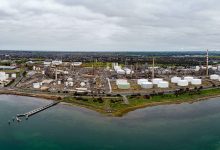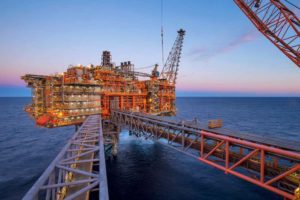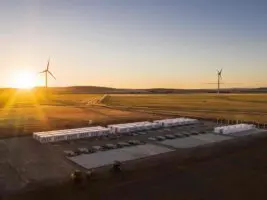Geelong Grammar, the Geelong Cats AGL club, and the Victoria National Parks Association have joined local school children, nurses and doctors to send more than 2000 submissions on Viva Energy’s plan to build a floating liquefied natural gas (LNG) terminal in Geelong.
Most oppose the project, which some described as ‘potentially dangerous’, ‘environmentally risky’ and ‘economically unwarranted’.
The bulk of the 2,043 submissions sent to the Victorian Government came from Geelong and Corio Bay residents, citing likely environmental damage caused by proposed dredging and the threat of a gas explosion in a terminal just hundreds of metres from residential areas.
The prestigious Geelong Grammar School in a 20-page report expressed extreme concern that the project “will exacerbate the existing safety risk posed by the refinery to its students, staff and residents and further interfere with its ability to provide a safe, healthy, and productive environment for education”.
Geelong Grammar pupil Millie Forewood claims the project is “irresponsible” and “dangerous”, posing a “catastrophic environmental threat”.
Millie pleads, “please don’t destroy our bay!”
Geelong-based Sister of Mercy, 76-year-old Margie Abbott claims more polluting gas is not needed in Geelong, suggesting she is “appalled that at the height of climate change this proposal is being considered.”
The impacts of climate change were also of concern to Dr Elizabeth Bashford from Doctors for the Environment Australia.
“There is an imperative to drastically reduce our reliance on fossil fuels by 2030,” Bashford writes. “Constructing infrastructure to import LNG into the Victorian market for the next two decades is not the way to a low carbon, more liveable future for the next generations.”
Matthew Sullivan Kilgour from Ironbark Sustainability suggests the “annual emissions associated with Viva Energy’s gas terminal are between 9.5 and 11.6 times higher than stated in the Viva Environment Effects Statement (EES)”, and will “increase the emissions of the City of Greater Geelong by 455,010 tCO2e each year”.
LNG/gas analyst Bruce Robertson from the Institute for Energy Economics and Financial Analysis (IEEFA) says gas import terminals are intrinsically high greenhouse gas emitters and Viva’s EES has been overtaken by recent events.
“The proposed terminal will not lower prices for Australian consumers,” Robertson writes. “The war in Ukraine has changed global LNG pricing dynamics for the foreseeable future. Current spot market prices make importing gas an economic impossibility.”
Robertson suggests there’s no need for more gas to support electricity generation as gas is only used as a niche application in the power system for peak energy generation.
He says the project should be rejected on the grounds of a lack of domestic demand, existing gas surpluses in the domestic market, and the availability of cheaper domestically sourced gas.
“Approval of more gas infrastructure is entirely inconsistent with the Federal and Victorian government commitments to net zero by 2050.”
Safety and risks to locals is a big concern of a contingent of Geelong nurses with Jacqueline Kriz writing: “Some residents live only 250 metres away from the Corio Bay Shipping Channel with 30,000 residents living within 3.5 km. Dredging of the area is going to disturb the toxic contaminants within the seabed, which will be impossible to contain.”
Shannon Hurley from the Victoria National Parks Association also focussed on dredging, claiming additional LNG carriers pose extreme risks “to marine mammals and other marine life from vessel strike, increased marine underwater noise and the chance of additional pressure from marine pests.
“These are all serious risks and have not been assessed adequately.”
The Port of Geelong agreed the environmental effects of the project had not been properly assessed and quantified. The authority doesn’t want the project to proceed “without further assessment” and identification of risks.
“The lack of meaningful consultation with GeelongPort and the failure to properly assess how the Project will impact GeelongPort represent a significant deficiency,” they wrote.
A voice of support was found in Geelong Chamber of Commerce’s submission which stated that in addition to the project being “safe”, it would provide “a non-permanent solution” to Victoria’s gas needs “as we transition to renewables”.
Likewise, Simon Kelleher from the Geelong Cats Football Club is also in support, suggesting that “diversifying the use of the refinery site supports Viva Energy’s ongoing economic contribution to the region”.
Lifelong local Philip Talihmanidis opposes the terminal, saying, “In the event of a catastrophe, the lives of the survivors would still be impacted for years.
“The fossil fuel mentality is part of Geelong’s past and has no place in its future.”
The International Energy Agency’s Net Zero to 2050 roadmap states there must be no new oil and gas projects globally from 2021 if the world is to have any chance of reducing rapidly increasing emissions and getting anywhere close to 1.5 degrees Celsius, with the world now on a 3-4 degree C trajectory.
It will be interesting to see how the Victorian government weighs up strong local views with global and state climate ambition when assessing Viva Energy’s project.
Tim Vaughan, is Financial Editor, IEEFA










